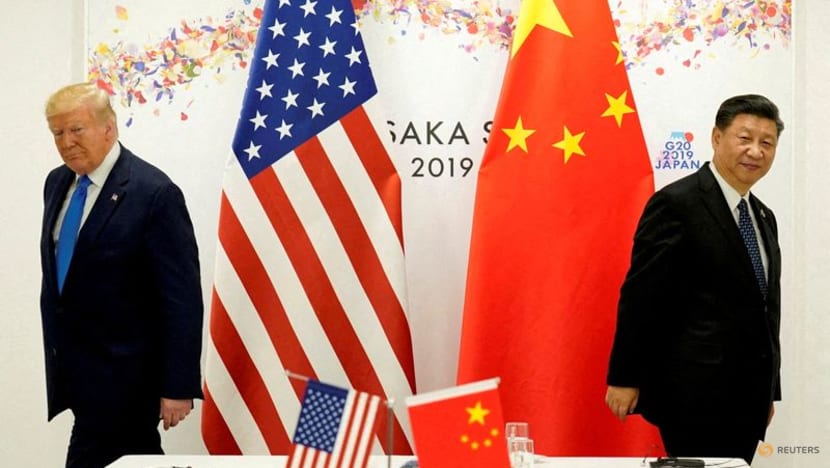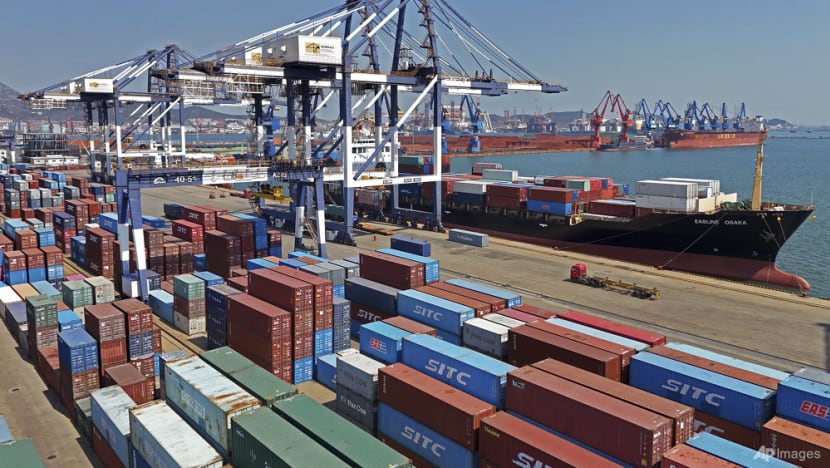analysis East Asia
Trump tariffs: China's tougher response in trade war 2.0 signals readiness to decouple from US economy
Tariffs that the United States and China have slapped on each other’s goods will kill trade between both sides, say analysts.


This audio is generated by an AI tool.
SINGAPORE: China has responded more forcefully and swiftly than before to United States President Donald Trump’s latest tariff salvo, said observers, citing how it has slapped retaliatory tariffs totalling 84 per cent on American goods just hours after Washington’s duties kicked in.
The move, announced by Beijing on Wednesday (Apr 9) evening and taking effect on Apr 10, signals a clear shift in posture, with China no longer appearing fearful of losing access to the US for both exports and imports, analysts said.
In a statement, China’s State Council Tariff Commission condemned the US for escalating the trade dispute, saying the decision to raise tariffs from 34 per cent to 84 per cent was a “grave mistake”.
“This move by the US severely infringes upon China’s legitimate rights and interests and deals a serious blow to the rules-based multilateral trading system,” the commission said.
Its pledge to “fight to the end” in response to cumulative US tariffs of 104 per cent on Chinese goods marks a significant departure from its more cautious stance in the early days of the trade war in 2018, during Trump’s first presidential term, said observers.
China now seems ready to decouple from the US economy, leaning on the years of work it has put into trade diversification, strategic planning and building political resolve, they added.
“Consider Trump 1.0 as a surprise that China was not ready for. Trump 2.0 is a war that China has prepared for eight years,” said Guo Shan, a China-based partner at Hutong Research.
“(China is) definitely much better prepared (now) to retaliate from all fronts, and boost the domestic economy to mitigate external risks.”
Within two days of the US initially announcing 34-per-cent tariffs on Chinese goods last Wednesday (Apr 2), China responded with reciprocal 34-per-cent tariffs on US imports that would take effect on Apr 10.
It also announced rare earth export controls, an expanded “unreliable entity” list with 11 American entities added, and anti-dumping investigations into imported medical CT X-ray tubes originating from the US and India.
In contrast, other zones and countries such as the European Union, Japan and South Korea that were also hit with US tariffs made preparations to negotiate with the US.
Back in 2018 to 2020 when Trump announced levies on various Chinese goods, observers described China’s response with its own list of US goods as a scramble.
During the first Trump administration, China largely avoided tariffs on high-profile US consumer goods such as iPhones and Boeing aircraft, a move seen by analysts as an attempt to avoid escalation.
Analysts say the Asian giant’s rapid and more forceful response to Trump’s latest salvos is not only tactical, but symbolic.
“China changed its tactic because its past restraint only served to embolden Trump,” said Xu Tianchen, senior economist for China at the Economist Intelligence Unit.
“It’s acting more aggressively, likely to force Trump back to the negotiating table,” Xu added.
While there are some analysts who say China and the US are negotiating, senior economist Xu Jianwei from financial services firm Natixis said: “I feel the room for negotiation is very, very, very small, because the target of the US has become very clear – at least, to China’s understanding – that is to contain China.”
The Chinese government has realised that it “makes little sense to continue with the negotiation”, its patience worn thin after years of talks with Washington achieved little, said Xu, who covers the Greater China region, at a webinar on Apr 7.
“(China) has been preparing for a further decoupling with the US,” said Xu, adding that its current posture reflects a broader shift not limited to trade, but across technology, finance and even cultural exchange.
“Under this strategic and economic fragmentation, I think China and the US are bracing for a Cold War paradigm in the future,” he said.
WHY CHINA ISN’T FLINCHING AT 104%
While China has now unveiled countermeasures against the additional 50-per-cent tariffs Trump announced on Monday (Apr 7) – which take the US’ cumulative rate to 104 per cent – Hutong Research’s Guo said a rate of “anything beyond 50 per cent is effectively toothless”.
A tariff rate of 54 per cent would effectively "kill" large-scale bilateral trade between the two countries, she explained.
“Tariffs at this scale have made it nearly impossible for Chinese firms to sustain supply to the US market. They have also rendered further tariff threats largely toothless, while generating broad domestic support for retaliation,” Hutong Research said in its research note on Apr 7.
Since 2018, China has diversified its export and import markets. The US now accounts for only 15 per cent of China’s exports, or 3 per cent of its gross domestic product (GDP), according to Hutong Research.
Meanwhile, most imports from the US can be substituted: With oil from the Middle East, gas from Australia, machinery from Europe and food from Latin America, the research firm noted.
“Semiconductors remain (China’s) most US-dependent input, but ongoing restrictions have already compelled Chinese firms to accelerate efforts toward self-sufficiency,” it wrote.
Xu of the Economist Intelligence Unit echoed Guo’s sentiments.
"Since China already faces a tariff rate in excess of 60 per cent, it doesn't matter if it goes up by 50 per cent or 500 per cent," he said. “This is essentially placing an embargo on US-China trade.”
“Filling the gap will be massive smuggling and transshipments that go beyond the US’ capacity to handle,” Xu predicted.
Some analysts say the effective tariff rate could be even higher – potentially topping 120 per cent – depending on how it is calculated.
During Trump’s first term, average US tariffs on Chinese goods jumped from 3.1 per cent in early 2018 to 19.3 per cent in 2020, according to the Peterson Institute for International Economics.
This level stayed mostly unchanged under President Joe Biden, with two small increases in September 2024 and January 2025 nudging the average up to 20.8 per cent.
Trump’s recent tariff increases – two 10-per-cent hikes in February and March, followed by a 34 per cent “reciprocal tariff” and another 50 per cent announced on Monday (Apr 7) – push the average rate to a record 124.8 per cent, marking the most intense and consequential phase of the US-China trade conflict yet.
In issuing a swift and forceful response in recent days, China may also have hoped to embolden other countries affected by Trump’s tariffs to take a firmer stance, said Lye Liang Fook, a senior fellow at Singapore’s ISEAS–Yusof Ishak Institute.
“But it seems that other countries are either not retaliating at the outset or choosing to negotiate first with America while contemplating countermeasures,” he said.

China’s State Council Information Office on Wednesday (Apr 9) released a white paper titled “China’s position on some issues concerning China-US economic and trade relations”.
It said China does not deliberately pursue a trade surplus, stating that the imbalance with the US is “an inevitable result of structural issues in the US economy” and the “comparative advantages and international division of labour”.
Separately, a spokesperson for the Ministry of Commerce said on Wednesday that China has filed a case against the US under the World Trade Organization’s (WTO) dispute settlement mechanism over the latest tariff hikes.
The spokesperson said US measures had “seriously violated WTO rules”, adding that the 50-per-cent increase was a “mistake on top of a mistake” and underscored the “unilateral bullying nature” of Washington’s actions.
China has also added 12 US entities to its export control list.
Zhang Zhiwei, president and chief economist at Pinpoint Asset Management, said China had sent a clear signal that it would maintain its stance on trade policy.
“It is also important to note the message in the white paper released today – that the government is willing to engage with the US on issues of mutual interest,” he added.

WHAT’S NEXT?
Xu from the Economist Intelligence Unit said he expects Beijing to also expand its export controls to more critical minerals.
“China is about to stop its agricultural imports from the US – like soybean, sorghum and corn – immediately. But I do think the two sides will go back to the negotiating table later, as the damages will be too large for the global economy – and either country – to absorb,” he said.
China could target the US’ services sector and impose restrictions on US films, two widely followed Wechat accounts, Niutanqin (Cow Play Piano) and Tuzhuxi (Chairman Rabbit), posted on Tuesday (Apr 8).
Hutong Research, in its Apr 7 research note, said it believes a currency agreement is more likely than a trade or investment deal, given the political and structural hurdles facing the latter two.
Beijing has “little appetite for a traditional trade pact”, the firm said, pointing out that China’s imports from the US are only one-third the size of its exports to America.
This imbalance, compounded by export controls, limits Beijing’s ability to meaningfully reduce the bilateral trade deficit.
An investment agreement appears even less likely, with America’s China hawks “showing little interest in encouraging Chinese investment” and shaping White House messaging through an “America First” agenda.
Related:
“That leaves currency as the most viable area for a potential agreement,” Hutong Research wrote, noting that a deal could serve both countries’ interests.
“China would benefit from a stronger RMB, while the US may favour a weaker dollar.”
A currency deal would not require approval of US’ Congress and could gain backing from institutions like the Treasury Department or Federal Reserve, particularly if Beijing agrees to purchase US Treasury bonds, as it did in the aftermath of the 2008 global financial crisis. This would help stabilise markets and lower interest rates, Hutong Research said.
Some experts believe China could use the tariff turmoil to build closer ties with more countries.
Former editor-in-chief of the South China Morning Post Wang Xiangwei wrote in an opinion piece for the news outlet that China should “capitalise on negative responses to Trump’s global trade war to champion free trade”.
“While Trump raises tariffs on the rest of the world, China should act swiftly to lower tariffs and other trade barriers with its major trading partners, including the European Union, Japan, South Korea and Australia,” he argued.
In his first public speech since the escalation of the trade war, Chinese President Xi Jinping pledged to strengthen strategic bonds with neighbouring nations by “appropriately” managing differences and enhancing supply chain ties.
His remarks were delivered at a two-day central neighbours work conference that wrapped up on Wednesday (Apr 9).
Xi is also due to make a state visit to Malaysia from Apr 15 to 17, the Malaysian government announced on Wednesday. He is reportedly visiting Vietnam and Cambodia as well.
Southeast Asia should be one of China’s top priorities for regional collaboration, said Li Yao, senior research fellow at the East Asian Institute of the National University of Singapore.
China can and should do more to support smaller economies, and it can go beyond opening the Chinese market, she said.
Chinese manufacturers are highly competitive, often to the detriment of producers in other developing countries, she noted.
“China should accelerate industrial upgrading and proactively shift certain segments of the supply chain to other developing countries through targeted industrial policies. This would allow emerging economies to occupy a greater share of the market, fostering their development,” Li explained.
“As these economies grow, their demand for Chinese goods will also increase – creating a virtuous cycle of mutual benefit.”





















